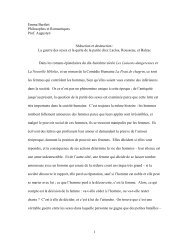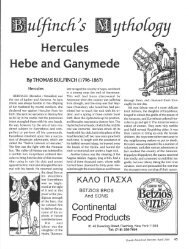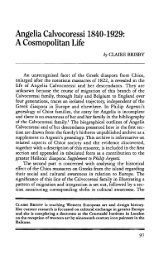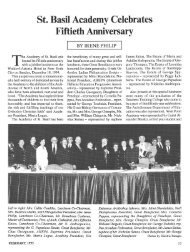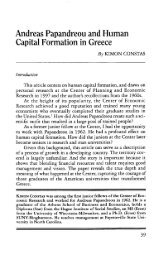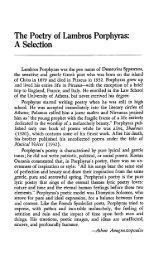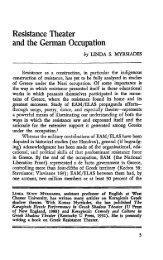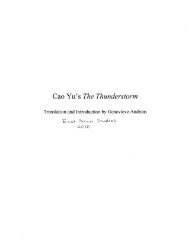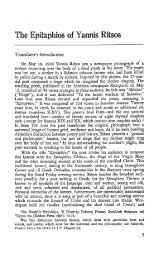THE FAYUM PORTRAITS AND THE DOXIADIS CLAN
THE FAYUM PORTRAITS AND THE DOXIADIS CLAN
THE FAYUM PORTRAITS AND THE DOXIADIS CLAN
Create successful ePaper yourself
Turn your PDF publications into a flip-book with our unique Google optimized e-Paper software.
afford the fees that embalmers charged,<br />
added a final touch: the painted portrait<br />
of the defund, a facial representation for<br />
the mummy's future life.<br />
"Now", says Dorothy Thompson,<br />
"almost two milleniums later, a present<br />
day Greek artist versed in the tradition<br />
of Byzantine icon-painting has come to<br />
gaze at the portraits. Thus the book took<br />
life...."<br />
Let us hear what the author has to<br />
say about the Fayum portraits.<br />
"Suddenly in the late 1880's scores of<br />
beautiful and mysterious portraits began<br />
to reach a Western Europe and the<br />
United States. They came from Egypt,<br />
12<br />
from a region called Fayoum, a short<br />
distance from Cairo. A few of these portraits<br />
were discovered earlier and others<br />
came to light since at sites outside<br />
Fayum as well, making a total of more<br />
then one thousand to date. Fayum is the<br />
name that has persisted over all others<br />
in archeology and art history describing<br />
them because more have been found<br />
there than anywhere else.<br />
"The Fayum portraits is the most outstanding<br />
body of paintings to have come<br />
to us from the ancient world, remarkable<br />
for their social and psychological<br />
insight and for their quality of art. Andre<br />
Malraux described them as glowing<br />
with a flame of immortal life. Products<br />
of the Greek naturalistic tradition, the<br />
best of them painted directly from life,<br />
they have by some miracle of painting<br />
captured life itself..."<br />
"Yet", continues Euphrosyne, "those<br />
portraits have constantly been neglect-<br />
ed by historians and critics and are practically<br />
unknown to the general public..."<br />
Asked what she thought was the reason<br />
for this misconception, Euphrisyne says<br />
she can think of three reasons:<br />
First -- those portraits are not signed<br />
by any known artist. Even the same Fay-<br />
oum has been objected as not all portraits<br />
were discovered in the Fayum region.<br />
They are what is called "victims of<br />
aninymity."<br />
Secondly-- they are scattered all over<br />
the world, sometimes in different sec-<br />
tions of the same museum: as Greek<br />
portraits of Egyptian mummies which<br />
date from the Greco-Roman period,<br />
they are often found in the Egyptian,<br />
Greco-Roman and Coptic department.<br />
And, Thirdly -- they were initially<br />
dogged by the reputation that they<br />
might be fakes as they had been so overrestored<br />
by their collectors that all<br />
seemed possible.<br />
The author of this book is a painter<br />
in her own right. Born in Athens, she<br />
was lucky enough to have had as her first<br />
teacher, rather her mentor in art, the<br />
famous Yannis Tsarouchis. There is no<br />
doubt that her interest in the Fayum<br />
portraits was kindled by him as he himself<br />
had been greatly influenced by the<br />
Egyptian portraits. Her studies later in<br />
Europe and the U.S.A (Oscar Kokoscha<br />
School of Painting in Austria, The Slade<br />
School of Fine Arts in London, the<br />
Cranbrook Academy of Art in Michigan<br />
and lately the Wimbledon School<br />
of Art in London), all but developed her<br />
desire to look deeper into what she calls<br />
the first surviving portraiture in history.<br />
Euphrosyne's Doxiadis comes from<br />
a well-known and very respected family<br />
in Greece. Her grand father, Dr. Apostolos<br />
Doxiadis, a pediatrician, was born<br />
in what used to be called Anatoliki<br />
Roumelia, the Greek speaking province<br />
of Bulgaria. The family was well off and<br />
the two sons were sent to Germany to<br />
study medicine. (Actually the grand fa-<br />
GREEK-AMERICAN REVIEW



